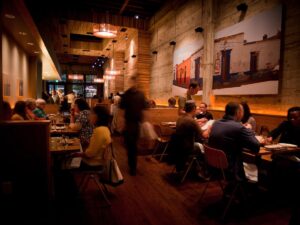Summary
- "The vibe—or atmosphere—of a restaurant plays a crucial role in shaping your dining experience."
- "Reading a restaurant’s vibe and choosing the right time to visit is an art."
When choosing a restaurant, most people focus on the menu, reviews, or recommendations. But the vibe—or atmosphere—of a restaurant plays a crucial role in shaping your dining experience. From the lighting and décor to the music and crowd, a restaurant’s vibe can significantly affect your mood and overall enjoyment.
Understanding how to read a restaurant’s vibe and timing your visit for the right experience can help you maximize your satisfaction. Whether you’re looking for a romantic dinner, a lively hangout with friends, or a quiet meal for contemplation, mastering the art of selecting the perfect time and place is key.
Here’s a comprehensive guide to decoding a restaurant’s vibe and finding the ideal time to visit.
The Importance of a Restaurant’s Vibe
The vibe of a restaurant is its personality. It encompasses everything from ambiance to energy and dictates the overall experience for diners. Why does this matter?
- Enhances Mood: A cozy, candlelit space might be perfect for a romantic date, while a vibrant, bustling atmosphere could energize a group gathering.
- Sets Expectations: A fine-dining restaurant’s quiet elegance signals a slower, refined meal, while a casual eatery might encourage quick bites and casual conversation.
- Complements the Occasion: Matching the vibe to your purpose—whether it’s a celebration, work meeting, or solo retreat—ensures your expectations are met.
Key Elements of a Restaurant’s Vibe
To accurately read a restaurant’s vibe, pay attention to the following elements:
1. Décor and Design
The design of a restaurant often communicates its intended vibe.
- Formal Décor: Think white tablecloths, soft lighting, and elegant art—indicative of upscale or romantic settings.
- Rustic Charm: Exposed brick, wooden furniture, and warm tones often suggest a casual, homey feel.
- Trendy and Modern: Minimalist furniture, neon signs, or industrial finishes point to a contemporary, social space.
- Cultural Aesthetics: Décor inspired by specific regions or traditions gives insight into the restaurant’s cultural theme and ambiance.
2. Lighting
Lighting can dramatically influence how you feel in a space.
- Dim Lighting: Creates intimacy and is common in upscale or romantic restaurants.
- Bright Lighting: Indicates a casual, energetic, or family-friendly vibe.
- Colorful or Thematic Lighting: Suggests creativity, fun, and a focus on creating a unique dining experience.
3. Noise Level
The sounds in a restaurant provide important clues about its vibe.
- Quiet and Subdued: Common in fine dining or romantic settings, where the focus is on conversation and savoring food.
- Moderate Buzz: Indicates a relaxed yet social atmosphere, perfect for group gatherings or casual meals.
- Loud and Lively: Points to a party-like or high-energy environment, ideal for celebrations and nightlife.
4. Music
The type of music and its volume further clarify a restaurant’s personality.
- Soft Instrumental or Classical: Often accompanies elegant and formal dining.
- Upbeat Pop or Rock: Reflects a casual, lively vibe, suitable for young crowds or trendy spots.
- Themed Playlists: Restaurants with cultural or cuisine-specific themes often use music to enhance the authenticity of their vibe.
5. Staff Interaction
How staff interact with patrons is a subtle yet telling sign of the restaurant’s vibe.
- Formal and Reserved: Indicates a refined experience where service is professional but not overly personal.
- Friendly and Chatty: Suggests a casual and welcoming atmosphere where staff may engage more with diners.
- Efficient and Focused: Found in high-turnover establishments like fast-casual spots.
6. Crowd and Energy
Observing the patrons and their behavior gives insight into the energy of the space.
- Couples and Small Groups: Signal intimacy and quiet conversation, common in fine dining or romantic venues.
- Families with Kids: Often indicates a family-friendly, laid-back setting.
- Young Crowds and Large Groups: Suggests high-energy, social settings, often at trendy or nightlife-oriented spots.
Choosing the Right Time to Visit
The same restaurant can have different vibes depending on the time of day or week. Understanding these fluctuations will help you choose the perfect moment for your visit.
1. Morning and Brunch Hours
Many restaurants offer a calmer, relaxed atmosphere in the morning, making this an excellent time for peaceful meals.
- Best For: Quiet breakfasts, business meetings, or solo dining.
- Vibe: Typically relaxed and uncrowded, with soft morning music and subdued energy.
- Considerations: Arriving early ensures a serene experience before crowds pick up during brunch hours.
2. Lunchtime
Lunchtime vibes vary widely depending on the type of restaurant and its location.
- Best For: Quick bites, casual meetings, or catching up with friends.
- Vibe: Casual and bustling in urban areas, quieter in suburban or fine-dining restaurants.
- Considerations: Lunch specials often attract office workers, so timing your visit slightly before or after peak lunch hours (12 PM–1 PM) can help avoid crowds.
3. Late Afternoon
Between lunch and dinner, many restaurants experience a lull.
- Best For: Quiet time for reading, working, or enjoying a snack.
- Vibe: Calm, with minimal activity as staff prepares for the dinner rush.
- Considerations: Not all restaurants operate during this time, so check hours in advance.
4. Dinner Hours
Dinner service is when many restaurants shine, offering their full menu and signature ambiance.
- Best For: Romantic dates, family dinners, or celebratory meals.
- Vibe: Can range from intimate and elegant to lively and festive, depending on the restaurant.
- Considerations: Early dinner (5 PM–6 PM) is usually quieter, while prime time (7 PM–9 PM) brings peak crowds and energy.
5. Late Night
Some restaurants and bars cater to night owls, offering a distinct vibe after regular dinner hours.
- Best For: Socializing, nightlife, or satisfying late-night cravings.
- Vibe: High-energy and often louder, with dim lighting and music taking center stage.
- Considerations: Menu options may be limited, focusing on snacks or signature items.
6. Weekends vs. Weekdays
A restaurant’s energy often changes dramatically between weekdays and weekends.
- Weekdays: Quieter and more predictable, ideal for peaceful dining or business meals.
- Weekends: Attract larger crowds, creating a lively and sometimes chaotic atmosphere. Perfect for group outings or celebrations.
Matching the Vibe to Your Occasion
To ensure the best experience, consider your purpose for dining out and match it to the restaurant’s vibe and timing.
- Romantic Dates: Look for dim lighting, soft music, and quieter settings. Early dinner or midweek evenings are ideal for intimacy.
- Family Gatherings: Casual, family-friendly spots with moderate noise and varied menus work best. Lunchtime or early evening visits accommodate all ages.
- Celebrations: Choose high-energy venues with vibrant décor and music. Weekends or late-night visits amplify the festive mood.
- Solo Dining: Opt for calm, welcoming spaces with comfortable seating. Morning or late afternoon slots provide solitude.
- Business Meals: Seek professional settings with minimal noise. Mid-morning or early lunch visits ensure a productive atmosphere.
Observing Subtle Clues Before Arriving
Sometimes, you can gauge a restaurant’s vibe before stepping through the door.
- Online Presence: Photos, reviews, and social media profiles often showcase the restaurant’s ambiance.
- Menu Design: A sleek, minimalist menu suggests formality, while playful fonts and casual descriptions indicate a laid-back vibe.
- Reviews and Recommendations: Patrons often mention the vibe in their feedback, giving you insight into what to expect.
Being Flexible
While understanding a restaurant’s vibe and timing your visit can enhance your experience, flexibility is key. Unexpected factors like special events, weather, or holidays can alter the usual ambiance. Embrace these changes as part of the adventure and enjoy the unique energy they bring.
Conclusion
Reading a restaurant’s vibe and choosing the right time to visit is an art that can elevate your dining experiences. By paying attention to décor, lighting, music, and crowd dynamics, you can gauge the atmosphere and decide whether it suits your purpose. Timing your visit based on the type of restaurant and your preferences ensures a perfect match for any occasion. With these tips, you’ll be better equipped to navigate the world of dining out and make each meal memorable.
As of October 2023, many restaurants are increasingly incorporating technology to enhance their vibe and customer experience. Interactive digital menus, mood lighting controlled by apps, and curated playlists that adapt to the time of day are becoming more common. Additionally, some establishments are experimenting with augmented reality (AR) to offer unique dining experiences, such as virtual tours of the restaurant’s history or immersive cultural themes. These innovations not only add to the ambiance but also provide diners with a more personalized and engaging experience.










Understanding a restaurant’s vibe can truly enhance your dining experience. It’s fascinating how elements like décor, lighting, and music play such a significant role in setting the mood and matching the occasion, whether you’re out for a romantic dinner or a lively celebration with friends.